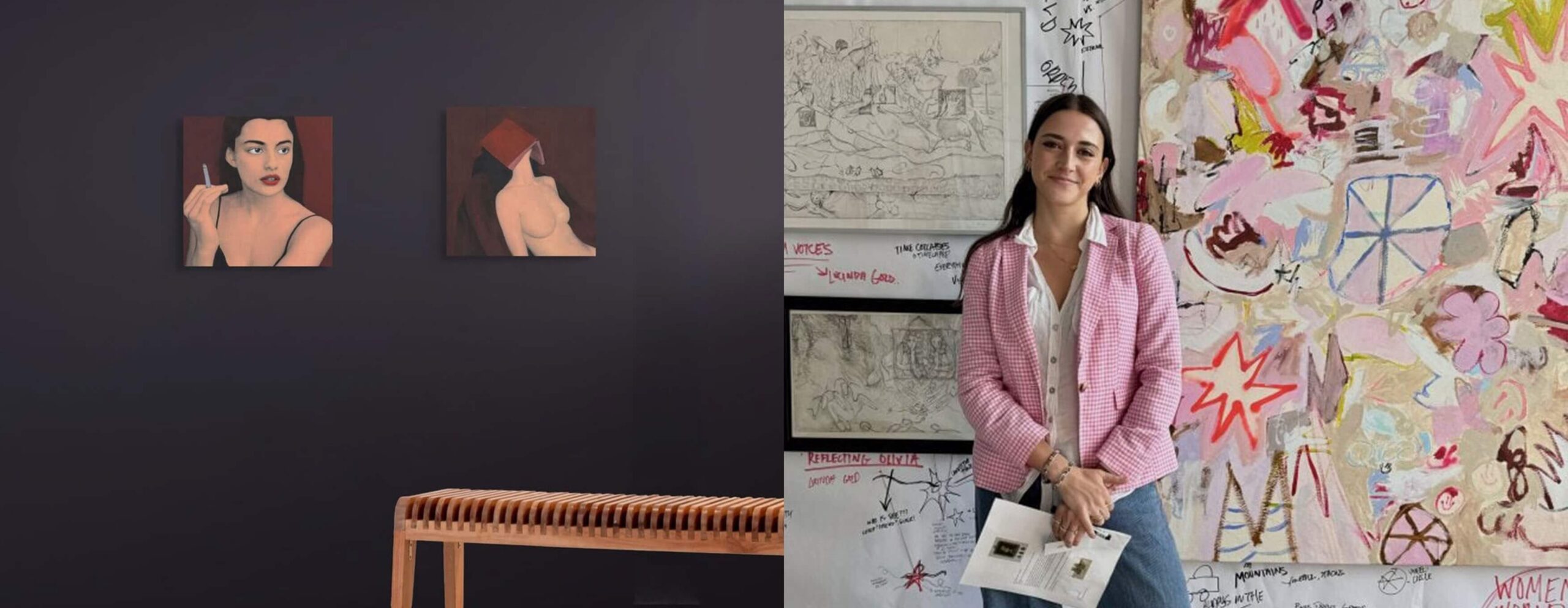Customer Stories
How Harsh Collective is using digital tools to grow, engage, and inspire the art world
Harsh Collective opened its doors in 2022, but its history reaches back to New York City in the ‘60s. Etta Harshaw grew up in the art world; both her maternal grandparents were painters and heavily involved in advocacy for legislation to create affordable housing for artists, which culminated in the Artist-In-Residence law that allowed artists to legally use former commercial buildings as spaces to live and work, and helped the NYC art gallery scene flourish.
For Etta, this was a sort of utopia: she grew up within the communities they had built, going to openings and witnessing the communities of artists her family had built. She studied art history and design in college and interned in the art world, which gave her insight into the art world business:
“I interned in the art world between my junior and senior year of college. From my experiences with my grandparents, I had developed an idealized view of the artist experience and found myself disappointed when I didn’t have enough information on artists or exhibitions to answer visitors’ questions at the gallery. I spent the summer imagining all the things I might do differently if I were to run my own gallery”.
Luckily, the universe answered. Back in the ‘60s, Etta’s grandparents had purchased two buildings in the West Village, and when they sold, she received the financial opportunity to explore the dream of opening her own gallery:
“Once that thought popped into my head, I couldn’t think about doing anything else. Throughout my senior year of college, I approached all of my classes and projects through the lens of building an art gallery, creating a business plan, and soliciting feedback from professors and peers. Within a month of graduating, I established Harsh Collective as an LLC and dove right in.”

Harsh Collective’s booth at the 2025 Affordable Art Fair New York.
Contents
Reshaping the gallery business by putting artists and community at the center
Harsh Collective strives to inspire a new era in the art world through putting artists first, demystifying galleries and art collecting, and building a community between artists, visitors, and artworks. The gallery believes everyone should be able to enjoy art, and it strives to create a space where people and art can come together to form stronger bonds.
Harsh Collective defines itself as “artist-first.” What does that mean to you in practice?
Harsh Collective enacts our mission of being “artist-first” in a few ways! Every time I work with an artist, I start with a meeting or studio visit where I get to know them and their work on an intimate level and share a little about Harsh and our mission. From those initial meetings, I work directly with the artist to create a collaborative environment that gives them the space and resources to bring their ideas to life. For example, our show Apartment 26 with Uzo Njoku involved an installation where we physically recreated the apartment featured in the paintings to make the show immersive and highlight Njoku’s design products. We spent about two weeks building and installing together every day in preparation for the show.
Beyond exhibitions, I focus on being a support system for my artists. Frequently, artists will ask me for feedback on their practice, a new series, a business decision, or advice for navigating the art world. It means a lot to me that my artists trust me and value my thoughts, and I make it a priority to remain up-to-date on their practices (and their personal lives!).
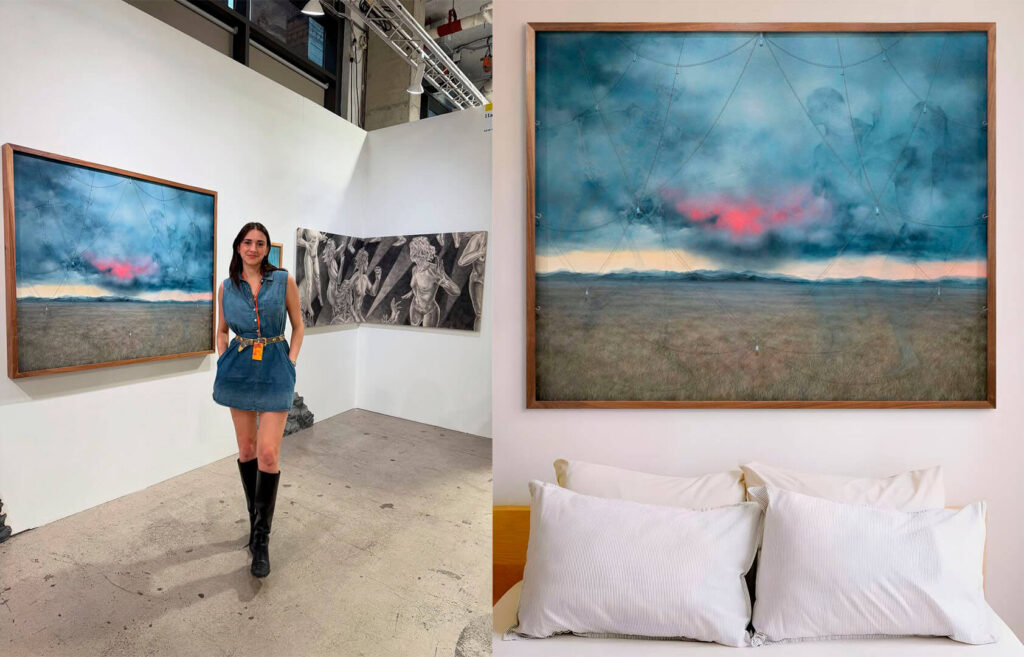
Etta Harshaw with a piece by Masha Morgunova at a live show and in one of ArtPlacer’s Room Mockups
One of your goals is to demystify the gallery space and make it more welcoming. What steps do you take to make art more accessible to every visitor?
I founded Harsh Collective with the goal of maintaining accessibility; it was a business plan I developed and a model that I had the opportunity to control as it grew. Without a long career in the art world, I was able to consider different methods with a new perspective and develop practices that truly contribute to accessibility. There’s an inherent openness at Harsh because we look to adapt to the needs we see in the art world from the ground up. We work to make our social media feel personal, and I often provide insight on the curation and exhibition process to help people understand how galleries operate.
We use tools like ArtPlacer to create personalized, curated experiences for global audiences. I source artists from social media a lot — it’s a space where artists can display their work at no cost, demonstrate their practice’s development, and develop a persona that we can be assured matches the ethos of Harsh Collective. I always prioritize female and underrepresented artists, to make sure there’s diversity in perspectives that can be lacking in other areas of the art world. We also aim for financial accessibility; we work with our artists to create merchandise and prints that are more affordable, as well as create our zine, which combines writing, art, and design at a very low cost. I hope that anyone can walk away from our exhibitions with something to take home, even if it’s just a postcard or sticker.
We strive to make openings feel as welcoming as possible, too. Besides posting about openings and sending email blasts, we promote them on @thirstygallerina, an Instagram page that shares gallery openings in New York City, to raise awareness and reach new viewers. We’ll often have activations that encourage participation, like at our exhibition Flash, where we had some of the artists tattooing in the gallery for the opening. We also partner with other organizations that don’t have a physical location to bring our communities together and encourage overall collaboration in the art world.
You describe Harsh Collective as a creative hub for relationships between artists, collectors, and the public. How do you foster that kind of connection, online and in person?
We foster connections between artists, collectors, and viewers in a few ways, but I think our zine best exemplifies this cross-section. For our online exhibition, Irresolute, we held an open call to source artists and writers for the accompanying zine. The publication offers an opportunity for Harsh to connect with artists who might not already be on our radar or whose work doesn’t quite fit within the theme of an exhibition. The zine also allows us to discuss artwork in a way that press releases and exhibition descriptions can’t. It’s where we can more thoroughly incorporate criticism and connect contemporary work to art historical conversations. I typically write a letter from the editor that starts every edition; it’s a moment where I can be vulnerable and share how our art and curatorial themes impact me.
My hope is that in sharing my views, other people will feel encouraged to explore how art affects them and can connect to Harsh as a whole. The zine can be purchased as a physical or digital copy, so anyone can access the writing and art we feature. Looking ahead, my goal is to host panels at our next physical space, further connecting artists and new collectors through relevant topics that help develop themes.
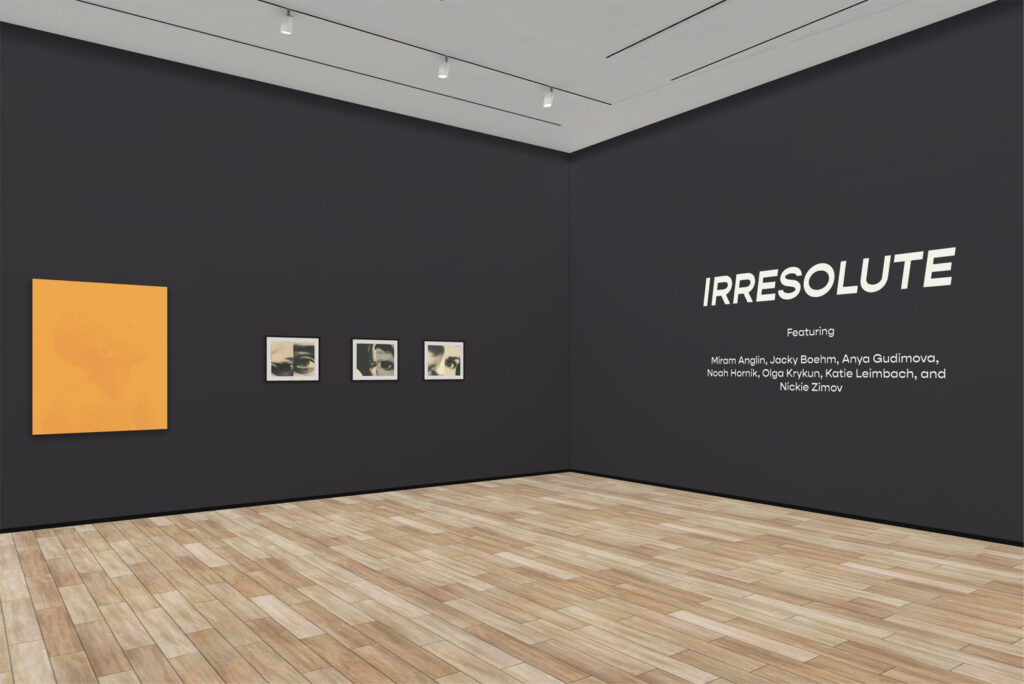
Irresolute explores the double edge of resolutions and champions change and indulgence
through abstract and figurative pieces.
Using ArtPlacer to go beyond gallery walls and build lasting collector relationships
With Harsh Collective, Etta aims to curate and design exhibitions that showcase emerging and underrepresented artists through a rounded experience that includes exhibitions in a brick-and-mortar gallery, virtual exhibitions and online presence, and projects like zines that allow everyone to take a piece of the art with them. Irresolute, inspired by the New Year in 2025, is one such exhibition:
“I had been thinking about how resolutions can be a double-edged sword. On one hand, it’s great to strive for self-betterment, but on the other, resolutions often lead to negative behaviors like disordered eating or negative self-talk. Through my curation, I wanted to express that failure and indulgence are a part of life, and people don’t need to punish themselves for perceived bad habits. I realized that the word “resolute” itself was very black and white, so I titled the show Irresolute to suggest to viewers that it’s perfectly fine to be unsure in life, unsure about anything and everything. The exhibited works varied from abstract pieces that embrace processes of change to figurative works that portray indulgences.”
Digital tools like ArtPlacer help make art more accessible, both for visitors and collectors, and gallerists and artists. This was important to Harsh Collective to further its mission of reaching and including communities that have historically been sidelined in the art world, so Virtual Exhibitions was perfect for curating and hosting Irresolute.
To craft the space, Harsh Collective made creative use of ArtPlacer’s features. For a first look upon entering the site, the gallery combined an existing virtual gallery with a ready-made Room Mockup. Once inside the exhibition, the space looks different, carefully customized to create a delicate interplay with the pieces, letting them shine. Plus, Virtual Exhibitions asks each visitor to complete a simple form upon entering the show, which allows Harsh Collective to learn about its guests and reach out directly to them, building a stronger connection.
You used ArtPlacer’s Virtual Exhibition for this show, including Room Mockups and a lead capture form. What impact did these tools have on engagement and visibility?
One of the key advantages of using ArtPlacer’s Virtual Exhibition feature is the ease and accessibility it brings to engaging with artwork. Initiating an inquiry, whether about availability or pricing, can sometimes feel intimidating in a traditional gallery setting. The option to send an email directly removes that pressure, making the interaction more comfortable and approachable for some collectors. With an online exhibition, viewers can take their time to look at a piece and can navigate through the space without having to worry about getting in someone’s way or blocking someone’s view. These virtual tools enabled the gallery to share our exhibition Irresolute with a wider, global audience. Anyone can step into the experience, allowing us to expand our reach and connect with diverse viewers while still maintaining the integrity and intentionality of a curated show.
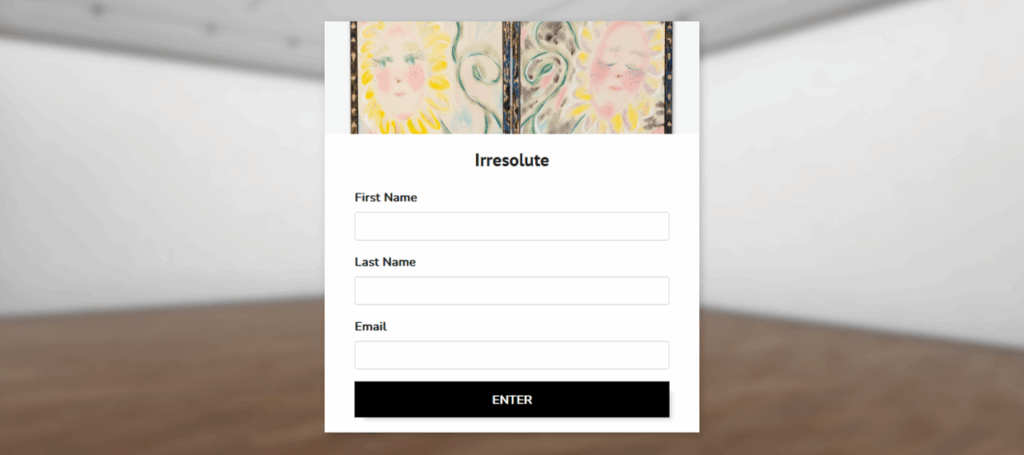
To access a Virtual Exhibition, visitors are asked to complete a simple form.
The information gets aggregated in ArtPlacer’s CRM, making it easy to reach out directly.
Many galleries struggle with turning online interest into actual connections. How did using a lead capture form and CRM help you follow up and build those relationships?
Using ArtPlacer’s lead capture form has allowed the gallery to streamline and organize inquiries in a meaningful way. At busy openings and fair booths, it can be easy to misplace a business card or email. With the data collected through ArtPlacer, we’re able to take a more curated and strategic approach to our outreach. When we receive an inquiry, we can not only offer information on artworks but also continue the conversation in a thoughtful, personalized way. For example, when a collector inquired about a piece through the Affordable Art Fair’s partnership with ArtPlacer, I followed up by offering tickets to the fair, and we ended up meeting in person. This is an effective tool for connecting with audiences who haven’t yet visited the gallery in person. Whether it’s an invitation to a preview, a fair opening, or a special event, it turns a simple inquiry into the beginning of an ongoing relationship with the gallery.
How do you think online exhibitions compare with in-person shows in terms of impact, accessibility, and connection? What have you learned from hosting both?
There are valuable advantages to both online and in-person exhibitions! Of course, there’s nothing like seeing an artwork in person, but openings can be busy and overwhelming, which can make it difficult to truly connect with the work. In contrast, online exhibitions can offer collectors a chance to engage with art more intimately and at their own pace.
Online shows have opened up exciting possibilities for us at Harsh Collective. Tools like digital mockups help provide a sense of scale and context for collectors that’s often missing in static PDFs, and installation images and dimensions alone rarely convey how a piece will actually look in a real space with specific colors, lighting, and textures. Virtual exhibitions also allow the gallery to collaborate with artists we might not otherwise have the opportunity to work with, whether due to geography, exhibition schedules, or shipping logistics. By featuring work digitally, we are able to save time and resources for both the gallery and the artist, and eliminate concerns around customs delays or lost shipments. This flexibility extends to our audience as well. Virtual exhibitions enable us to share our programming with viewers across the globe, offering an accessible and immersive experience that goes beyond what a single installation image can capture.
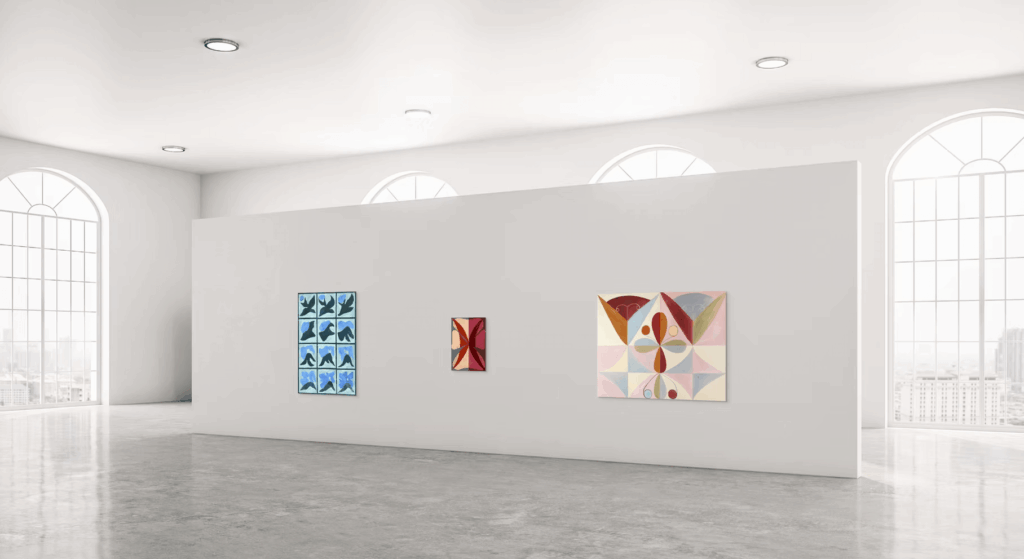
Harsh Collective combined ArtPlacer’s Room Mockups with Virtual Exhibitions to create a unique online space.
Expanding Harsh Collective’s vision with playful, purposeful shows
As Harsh Collective continues to evolve, its artist-first approach to exhibitions and business is what sets it apart. From community-driven shows to practical advice for emerging gallerists learning to navigate the art world, founder and driving force Etta is focused on building a gallery model rooted in appreciation for both the art and the artists.
What’s on the horizon for Harsh Collective? Are there any upcoming shows, collaborations, or digital projects you’re especially excited about?
We’re really looking forward to our upcoming summer exhibition at the gallery, Pet Shop. The show features artworks centered around animals, and we’re especially excited to engage pet owners as part of the experience. It’s a playful way for us to show audiences that the gallery is a space to be enjoyed. With Pet Shop, we’re intentionally moving away from the traditional solemnity often associated with galleries. A love for animals is something so many people share, and we’re thrilled to create an exhibition that invites joy, connection, and a sense of familiarity.
Finally, what advice would you give to other young gallerists or curators who are trying to build inclusive, forward-thinking spaces like yours?
I say this pretty often, and I’ll say it again: go out and do things! Make connections, attend openings, have conversations, and really listen. You don’t have to take everyone’s advice, but the more perspectives you understand, the better equipped you are to make informed decisions. You have to start somewhere, so take that first step and see how people respond. Flexibility is key. When I launched Harsh Collective, I had a lot of big ideas, many of which didn’t quite make sense once we were in motion. The gallery embraced the lean startup model so we could pivot quickly when something wasn’t the right fit. That shift led us to successfully participating in a multitude of art fairs and eventually incorporating online exhibitions alongside our in-person exhibitions and events.
There was so much I didn’t know about running a business and navigating the art world in the beginning, and there’s still plenty I’m learning. But being open to change, learning from missteps, and experimenting with new approaches has been the most valuable part of the journey with Harsh Collective.
Editor’s note: This interview has been edited for length and clarity.
